Justin Robinson's Blog, page 3
October 21, 2016
Now Fear This: The Witch

That, friends, is some stunning yonic imagery.
One generation’s bogeyman is the next generation’s punchline. What we find frightening in movies, books, and stories has to do with the concerns of the day. This is why periods of anti-communist hysteria produced films about sinister aliens replacing normal people with perfect duplicates, sexualized serial killers and outbreak zombies preyed on us during the AIDS pandemic, and with the proliferation of new religions in the Nixon years, a spate of Satanic-themed horror flicks invaded the theaters. A generation creates the bogeymen that will frighten it, to paraphrase Hannibal Lecter: we don’t seek things out to be scared of; we’re frightened of what we see every day.
By the time the next generation takes over, the previous generation’s monster has been mined to oblivion. The context for the initial fear has been replaced by a new concern, so all that’s left are the shadows on the screen. What traumatized the parents amuses the children. This is what makes delving into the past to create a horror film out of the portrayal of a bygone generation’s monster so tricky. You’re not playing on the fears of the audience now, you’re playing on the fears of the audience then, and attempting to make that relevant. It’s nearly impossible.
So when it’s done well, it’s an achievement to be lauded. The Witch was a sensation at Sundance — and deserves all of its accolades — so it’s a little more high-profile than I generally cover here. But when something is crafted with this much care, beautifully shot and realistically portrayed, I can’t ignore it. That, and it’s total history porn.
That is what endeared me most to The Witch. It’s a great movie on any level you can judge a film, but if you take the time to get the history right, that will be what elevates it for me. The film takes place in the 1630s, and the script was written using primary sources from that time. The dialogue has a pleasing rhythm where individual words might be lost on a modern speaker, but the meaning is indelibly conveyed. A lesser filmmaker might have succumbed to the temptation of asking for stagey, Shakespearean performances from the cast (utterly missing the fact that Shakespeare was the low entertainment of his day). Not so here; the actors all give naturalistic readings, making all the thees and thous sound utterly at home in their mouths.
A family of puritan settlers get thrown out of their community when the father, William, gets a little too churchy for his fellow puritans. Apparently, his interpretation of the Bible is a tad different than theirs. While this would seem like a nothing detail, set up only to get to the rest of the action, it’s in fact a brilliant look into the mindset of the people of the time. In that small difference could determine the path to heaven or hell. It could come from the Devil himself. To a 17th Century puritan, the Devil wasn’t an allegorical figure that stands in for the evil of the world. He’s a real, live creature that tempts people away from the righteous path for his own ends, while God is an aloof master only too eager to condemn His children to the pit.
The family settles down on a patch of land just outside a deep and dark wood. While today, nature is something to be appreciated or even revered, to the people of the time, this was where the Devil held sway. Nature meant chaos and death. In essence, the film is creating a symbolism designed to be appreciated by the puritans who will never watch it. William has guided his family out onto the precipice of grace and damnation, and it will only take a little nudge to push them over.
This nudge takes the form of baby Samuel mysteriously vanishing during a game of peek-a-boo with eldest daughter Thomasin. The way this is shot, there is no way that the baby could have crawled away, and the idea that the culprit was a wolf is equally unlikely. The mother, Katherine, spends her days crying over the missing child and blaming Thomasin for the loss, while William desperately tries to eke a living out of a land that doesn’t want him.
Meanwhile, the farm is haunted by a pervasive dread. There is a witch in the woods, but whether she is responsible for the uncanny events around the farm is open to interpretation. In fact, much of the film is to its credit, which we’ll return to. Milk turns to blood, Caleb goes missing, Thomasin’s creepy twin siblings claim to speak to their evil-tempered goat, Black Phillip, and so forth and so on. Katherine is only too eager to see Thomasin as the source of the ill fortune. She was there when both Caleb and Samuel disappeared, and at one point loses her temper with one of the twins and claims to be a witch.
There are two major ways to interpret the film. The first is at face value. In this case, the irony is that Thomasin was a good and virtuous young woman driven to evil by the suspicions and weakness of those around her. None of her family is entirely righteous in the traditional sense. Her father is plainly outmatched by the harsh conditions, spending most of his time in the futile pursuit of cutting wood until an entire side of the cabin is covered in a huge, useless stack of it. There is no better way to illustrate one man’s helplessness against growing evil than that. He is also willing to let Thomasin take the blame for the loss of a silver cup, an item he sold to buy a rabbit snare.
In addition, Caleb is just coming into puberty, and with the utter lack of any other girls to look at, stares at his sister’s chest more than once. He’s brought low by this desire, the witch using her powers to beguile him in the image of a young, attractive woman. Caleb recites an uncomfortably sexual prayer about Jesus later, and though this seems like an invention, it’s an actual prayer of the time. Jonas and Mercy, the twins, claim to speak to a goat, and generally act like creepy kids every chance they get. Katherine is a miserable woman who heaps scorn on her daughter. Thomasin tells her mother she loves her only once, and when she says it says everything about their relationship.
The religion itself is a component in this bizarre abuse. Caleb worries constantly that he’ll be damned to hell. After all, Samuel wasn’t saved, so he’s burning for the crime of dying young. Falling to the Devil was so easy, it’s no wonder that some might take the path of least resistance. Thomasin’s first words in the film are a prayer for forgiveness. She’s broken every commandment — in her mind — and played on the Sabbath. They might as well throw their arms up and say, “Well, if the Devil wants me so bad and God is just looking for an excuse, I might as well!” Especially when the life of virtue is nothing but hard work and deprivation, when the promise of a pretty dress and a little butter to eat is enough. Katherine and the twins want to believe Thomasin is a witch, while William and Caleb are too weak to defend her from the accusations. Thomasin was as righteous as she could be, and her family, the ones who were supposed to love her and take care of her, turned on her as soon as they could. In this way, the movie once again preys on the fears of its characters rather that of its audience, making the former accessible to the latter.
There’s also the chance that Thomasin is merely suffering from mental illness. The mold growing on the family’s corn produces hallucinations, and could easily explain nearly anything that happens. While Thomasin’s increasingly wild hair (in the beginning, perfectly done under a white bonnet; in the end, a shaggy mane) can be used to track her fall from grace, it can also be seen as her surrender to the demons inside her own mind. Her family is still weak, but in this version of events, she was the one who killed baby Samuel and seduced Caleb in the woods.
Pregnant with this much symbolism and meaning, The Witch would already be a must-see. It also manages to excel visually. It is an absolutely gorgeously shot film. Using natural light, the scenes at night have the all-encompassing stygian dark, common in the cinema of the 1970s, punctuated by the golden flicker of a candle. Supernatural events are depicted in frank shots, encouraging the audience to take the as the characters do: as part of the world they don’t quite understand.
The Witch is the kind of movie that lingers with you for days, even weeks later. Single images or moments periodically resurface, begging for more analysis or another viewing. It’s a truly great film, a gift from not just the horror gods, but the cinema gods. And when someone asks if thou wouldst like to live deliciously, you say yes.
Filed under: Projected Pixels and Emulsion, Puffery Tagged: 17th century, history porn, Now Fear This, The Witch, woudst thou like to live deliciously?

October 14, 2016
Liner Notes
Sadly, for me, the answer is always iced tea. Always.
Undead On Arrival
A bone-crunching ultra-violent noir set after the zombie apocalypse. Chapter one, our (anti) hero gets bitten, and over the next twenty-three chapters, he’s slowly turning into a zombie while he tries to figure out who set him up.
The Dollmaker
Maybe the most disturbing thing I’ve ever written. A postmodern take on Frankenstein, about an emotionally crippled genius who uses pieces of his soul to create beautiful women out of the inanimate.
Mr Blank
He works for every conspiracy, secret society, and cult on the planet, doing the crap jobs no one else wants to do. On one of these errands, someone tries to kill him — bizarrely — and now he’s on the clock to find out who.
Nerve Zero
My first book is a science fiction noir set on a zero-gravity space station whose inhabitants have grown so used to weightlessness that they’ll suffocate in a normal environment. Their planet has been enslaved, and now one of the native sons returns home only to get sucked into the strange politics of his home.
Coldheart
A secret world of powerful mages and their inhuman servants fight an eternal war in the shadows. The first in an open-ended series exploring immortality, loyalty, power, and sometimes just good, ripping yarns.
Everyman
A broken man learns he has the ability to steal the lives of others. One of his victims grows steadily madder as his body mutates into a new and terrifying form. A woman tries to save her husband, but can she fight madness?
City of Devils
Los Angeles, 1955. Monsters are real. Werewolves are cops. Phantoms are musicians. Crawling eyes run the studios. Doppelgangers are actors. Humans are the downtrodden minorities, preyed on and changed. Now the last human detective is hired to find a missing mummy, and the whole city wants him dead.
Get Blank
The conspiracies only get weirder in the sequel to Mr Blank. When Blank’s girlfriend gets framed, he’s back into the crazy world he thought he’d left behind, threatened on all sides by Satanists, deranged movie stars, a self-help cult, and, of course, Bigfoot.
The Last Son of Ahriman
The first book in a trilogy, this is the origin story of a new kind of hero. Fighting fire with fire is a thing people say. In this one, he fights Cthulhu with Cthulhu. It wasn’t supposed to be him: his brother was killed forcing him into the mantle, but he does his job anyway.
The Dark Price of Ahriman
The second book in the Ahriman Trilogy finds Simon, the reluctant hero, accepting his mantle more completely. He’s beset on all sides by enemies, forcing him to reach out for help. Unfortunately, the help comes at an extremely high price.
Daughters of Arkham
My first collaboration, this is Lovecraft by way of David Lynch. Set against the backdrop of a community sharply divided by social and economic class, this is the story of Abigail Thorndike, a young woman whose life goes careening off the rails when she finds herself mysteriously pregnant.
There’s a peek behind the curtain! Enjoy.
Filed under: Level Up, Moment of Excellence Tagged: City of Devils, Coldheart, Daughters of Arkham, Everyman, Get Blank, Liner notes, Mr. Blank, Nerve Zero, The Dark Price of Ahriman, The Last Son of Ahriman, Undead On Arrival

October 7, 2016
Yakmala: Pink Force Commando
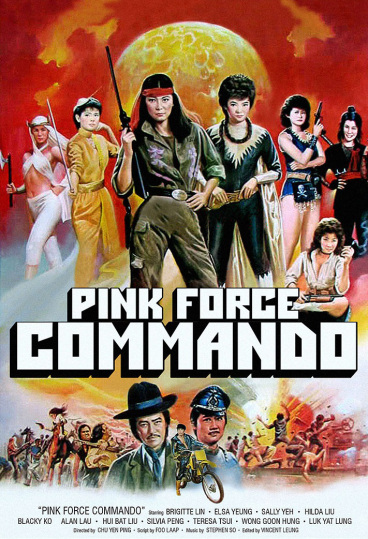
Admit it. You kind of want to see it now.
Holy shit, did you know dreams are real? Not like, “Hey, I had this dream, and it happened,” and you’re all, “Please don’t tell me another one about you eating nachos with Margot Robbie.” No, I mean somehow, in China, someone created the technology to transfer an actual dream onto film. That’s the only way I can explain 1982’s Pink Force Commando. Every other explanation somehow involves Cthulhu. Possibly eating nachos with Margot Robbie.
Tagline: Seriously? You think they bothered with a tagline?
More Accurate Tagline: Holy. Living. Fuck.
Guilty Party: I can only assume this is the work of Dr. Morpheus, who once held the world hostage with his Dreamulator Armageddetrix. After the United Nations paid him his billion dollar ransom, he apparently retired from villainy to make movies in Hong Kong out of the truly insane dreams he harvested in his bid to take over the world.
Synopsis: When I say this thing is like a dream, I mean it. Down to the point where you wake up, and you’re like, “How the fuck did I get here and why did I just pee for like six hours?” The entire movie opens with a shot that it takes a good hour to explain, and even then, I have no earthly idea what it’s doing here. It’s a a woman in a white halter top, looking like she can’t decide if she’s singing backup for Stevie Nicks or fighting Magneto, posing on a mountain at night.
Then it’s daytime. At a farmhouse. The army, led by a guy they call Pig Commander so that’s what I’m going to do, closes in on an all-female gang of thieves hiding inside. They’ve stolen some money or something. Jackal, the ostensible leader of the ladies, who sort of dresses like Che Guevara after someone gave him a Michael’s gift card, hatches a plan. Everyone else distracts the army, while she and her number two, Cat, escape with the loot. In a year, they all come back to the farmhouse and split it up.
Who would actually go for a plan like that? The ladies readily agree, making me think that Jackal specifically recruited from a head trauma ward. Jackal and Cat escape, but then it turns out Jackal and Pig Commander were secretly in cahoots. They steal the cash, leaving Cat behind.
Cat then is suddenly on an island. She’s grown out her hair and started dressing like a supervillain who exclusively attacks casino grand openings. She recruits a character named Dynamite Susie (more on that later), and they rendezvous with Rebel Angel (the only survivor of the original gang) at an Old West town that’s perpetually in the middle of Chinese New Year. Jackal and Pig Commander used the loot to found the town.
The gang confronts Jackal, and after some initial gloating, Jackal decides to make things right. By hacking off her fucking arm. Which… nice gesture, I guess, but an arm isn’t going to pay any student loans. I’m just going to assume that anyone calling herself “Rebel Angel” has student loans.
Pig Commander is annoyed, because he likes his ladies symmetrical. Still, he decides they can all get rich by stealing a giant diamond that somehow exists. They head out to get it, but the whole thing is a trap by Pig Commander. The diamond was a fake. Oh yeah, the Woman in White from the first part is back, and she’s a good guy? I don’t even know anymore. All I know is Tom Hardy is dressed up like Tom Berenger and trying to get me to make up with my dad.

And this fucking thing won’t stop spinning.
Cat, Rebel Angel, and Dynamite Susie get captured, but a wounded Jackal escapes, only to be rescued by a Sergio Leone movie. Yeah, there’s a laconic badass cowboy who lives off in the wilderness because fuck you Steve, I’m not taking notes on this script anymore. This character, The Heartbroken Man (yes, that’s seriously his name), nurses Jackal back to health, and why not, makes her a robot gun hand.
I need to repeat that, so it doesn’t get lost. A SERGIO LEONE COWBOY MAKES JACKAL A FUCKING ROBOT GUN HAND.
The newly encyborged Jackal breaks her old gang out of the clink and steals a map to… something. Who knows? It’s important to the plot but not important enough to explain. Then the whole group of them join the Woman in White at this town. I’m unclear. Were Pig Commander and his Ninja Leader going to attack this place, or did they make the call only after the map ended up there? Who knows?
A giant fight follows and everyone dies. Only the Heartbroken Man lives on, and he’s sure to ride into the town and then ride out just long enough so that he can ride away from an explosion. The Heartbroken Man does not fuck around.
Life-Changing Subtext: Love makes you do strange things. Like, really strange, illegal, completely barking mad things.
Defining Quote: “It’s an omen! The dying man will see the Heartbroken Man!” This is said on the way to get the giant diamond that doesn’t actually exist, and it’s the second time we see the Heartbroken Man (the first was after a minor ninja attack). How do omens already exist about this guy? How does everybody know who he is? Does everyone who sees him die? Actually… I buy that. He’s pretty badass.
Standout Performance: The only person I recognized here was Sally Yeh, playing Dynamite Susie, who basically comes off like if Daisy Duke had an unlimited supply of dynamite and an extremely limited supply of fucks. Yeh is most famous as Jenny, the blind girlfriend from The Killer, one of the greatest action movies ever made. I wonder if John Woo cast her after seeing this one?
What’s Wrong: That is the most coherent synopsis of this film you will ever read. That should tell you something.
Flash of Competence: When Pig Commander’s army marches on the village to get the map, the Anvil of Crom starts to play. That’s the Basil Poledouris-composed theme to Conan the Barbarian, a.k.a. one of the most ball-shatteringly awesome pieces of music ever to emerge from the all-shining womb of the godhead.
Best Scenes: The scene where Cat recruits Dynamite Susie is like the movie decides, you know what? Time to start over. They’re on this tiny island, Cat is unrecognizable in her cape and jumpsuit, and Dynamite Susie won’t stop blowing everything up around her like she’s a redneck version of Tim the Enchanter. Here’s the weird part: Cat has a whole army of mooks with her, that Dynamite Susie casually blows up. I get that Susie’s clearly better than them, but maybe don’t throw away the army you’ve built just because you have a crush on an attractive woman in cut-offs?
One of the most dangerous villains in this movie is a character I refer to in my notes as “the Motorcycle Enthusiast.” We first encounter him as a leader of a gang of toughs in Jackal and Pig Commander’s city, where he wounds Rebel Angel. She gets her revenge by beating him mercilessly later. Then he shows up again and fucking crucifies Rebel Angel before the final battle! He’s finally killed in the end when the Heartbroken Man beheads him. I don’t know who this guy is, but he had to be killed like the goddamn Highlander.
Jackal’s town has a standing ninja bounty. Makes no sense until you see that the forests are literally infested with the bastards, like deer ticks or something. But instead of lyme disease, they’re giving out throwing stars. So Cat goes out to collect, and who should she meet but the Heartbroken Man, who’s gunning down ninjas like it’s his hobby. The thing is, he doesn’t collect the bounty. Is… is he hunting ninja for food?
Transcendent Moment: I’m partially convinced this movie is pretending it’s in America, or at least as section of the source dream was. Because, among Pig Commander’s army is at least one Klansman. That’s right. There’s a member of the Ku Klux Klan with the bad guys. The thing is, in China I guess you can’t get proper Klan robes — there can’t be much of a demand there — so this guy clearly made his own. And he ended up with a nipple on his head. He looks like a Klansman with a reservoir tip.

Yeah… that’s probably for the best.
You need to see this movie. I don’t know how. I don’t know where. But track this thing down and watch it.
Filed under: Projected Pixels and Emulsion, Yakmala! Tagged: diamond theft, Dynamite Susie, Jackal, Pink Force Commando, Rebel Angel, robot gun hand, The Heartbroken Man, Yakmala!

September 30, 2016
Lifetime Theater: The Tall Man
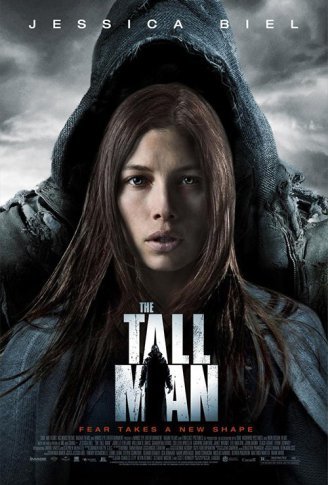
“I’m in what?”
My first clue should have been that The Tall Man wasn’t shot in the same nouveau-riche Vancouver suburb where every other Lifetime movie takes place. The second was that it wasn’t lit like a telenovela, and the credit sequence was a bunch of needlessly expensive helicopter shots. In short, it didn’t look like a Lifetime movie. But it was on the Lifetime Movie Network! What gives, Lifetime?
Well, like we learned when I did the original Mother, May I Sleep With Danger? (side note: you may), not every “Lifetime Movie” is technically a Lifetime Movie. The brand has gotten confused in our minds, causing the phrase to cast a wider net than it might otherwise. In this case, I made the erroneous assumption that anything on the Lifetime Network was made by their assembly line of steely mothers doing what needs to be done against an uncaring and often hostile world. The crazy thing is, even though The Tall Man has more artistic pop than a standard Lifetime offering, it’s pretty easy to see why they wanted it on the network to begin with.
One of the most surprising revelations I’ve had since my Very Special Journey took me into the weeds of the Lifetime Network, is that the channel produces horror movies. They aren’t instantly recognizable as such, since the bulk of horror films are produced for 18-25 year old men, and Lifetime makes them for 35-50 year old women. The things that scare the former group (clowns, zombies, hillbillies), aren’t the same things that scare the latter (dead kids, cheating spouse, hillbillies). Women have always had a (mostly deserving, I think) reputation for having it together more than men, and after tacking on a couple decades of experience they have a better idea of the dangers they’re likely to encounter. So finding an honest-to-god horror film inspired by the Slenderman legend — a legend focused around preying on children — isn’t at all surprising to anyone who understands the network.
Also unsurprising is that the main character is one of those steely single moms Lifetime has built the network around. She’s even played by an actress, Jessica Biel, whose career has descended from the heights it once scaled into a more modest form of success. She lives in an extremely depressed former mining town in Washington, separating it visually from Lifetime’s usual assembly line, but it was shot in British Columbia, so there’s still the whiff of the familiar, especially with the supporting cast all wrestling with various degrees of Canadian accents. She’s the closest thing the town has to a doctor, but she’s actually merely a nurse, her doctor husband having died years ago. She lives with her son and a live-in nanny. Not sure how that last one works. It’s possible she pays her in canned beans.
This town, Cold Rock, which is not a microbrewery despite the name, is suffering from a rash of child disappearances. The kids just up and vanish. They’re blaming it on the local legend of The Tall Man, who was named after all the good monster names were taken. Some of the locals think of him as a myth, or possibly a pedophile, or maybe a mythical pedophile. You know, like Pervertseus.
As with any story like this, our hero, Julia (Biel) has her child abducted by the Tall Man. But that’s when things get weird. For one thing, the nanny ends up bound, gagged, and bloodied, which doesn’t quite seem like the method of someone who makes people disappear without a trace. Then Julia straight up turns into the fucking Terminator and runs after the Tall Man, who’s riding around in a converted ice cream truck like the monster from Jeepers Creepers. Speaking of pedophiles.
Now we’re getting into serious spoiler territory. The Tall Man isn’t a bad flick all told. The town is atmospheric, Biel isn’t bad, and the twists are just mad enough to give it a sense of livewire energy. Stephen McHattie and the cancer man himself, William B. Davis, both play small supporting roles. I might even have featured this one in a Now Fear This, had I come to it in a different way. So that being said, if you’re at all interested in the movie, go check it out. It’s not the greatest thing you’ll ever see, but it’s agreeably insane. For everyone else, I’m going to spoil the living shit out of it.

Here’s your spoiler buffer.
Okay, anyone still here knows what they’re in for. After Biel loses her child and suffers some pretty severe injuries (she was dragged behind a truck, attacked by a dog, beaten in the head, and on that same truck when it flipped onto its side — like I said, the Terminator), she staggers into the local diner, which is curiously packed that late at night. When she leaves the room to clean up, everyone talks like she’s the bad guy. Then she finds an altar with her missing son’s picture and she gets the hell out of there. When the townsfolk find her gone, they pursue, like an honest to god angry mob.
Because that’s the first twist: Julia is the Tall Man. She’s been abducting the children around town, keeping them for a few days or weeks, and then killing them, disposing of the bodies in the surrounding woods or in the miles of abandoned mine tunnels the town sits on top of. The shadowy figure from what we thought was the abduction was actually the boy’s real mother, a homeless woman who lives in that creepy converted ice cream truck. Julia refuses to tell the police where the bodies are buried, instead unleashing a breathless manifesto that makes about as much sense as anything called a manifesto. Best case scenario with those things is that they don’t have bombs attached.
But that’s not the final twist. A minor character, played by Jodelle Ferland, is the daughter of Samantha Ferris (most famous as Ellen in Supernatural). Ferland’s character, Jenny, has a horrible speech impediment to the point where she doesn’t even speak unless she can help it. Her home life is a nightmare, with her mother having actual knockdown drag-out brawls with her sentient meth-twitch of a boyfriend. When Jenny is injured in one of these, she apparently runs off, to be taken by the Tall Man.
…who turns out to be Julia’s “dead” husband. They abduct the kids with crappy go-nowhere lives and give them to childless people who will presumably raise them right. Jenny gets placed with a rich woman, and though her life is demonstrably improved (she even speaks without difficulty), it’s hard not to be queasy at the blatant class politics at play. Stealing kids away from poor families was the justification for taking an entire generation of Native Americans from their parents. To the movie’s credit, it ends (with a horrible voiceover and Jenny looking directly into the camera, because this film can’t do anything right without first being thuddingly wrong) with a question rather than an assertion. Jenny isn’t sure if this really is better or not.
So what did we learn? If you’re going to be a monster, make sure you come up with a cool name first. Maybe put something distinctive on yourself, so your height isn’t the only thing people see.
Filed under: Projected Pixels and Emulsion Tagged: Jessica Biel, Lifetime Theater, Not actually Lifetime, plot twist, Slenderman, The Tall Man

September 23, 2016
Now Fear This: The Midnight Meat Train
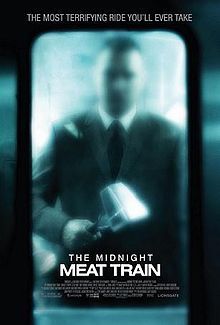 “It’s not as good as the book” is the most consistently leveled piece of criticism on any movie based on a book. There’s a very good reason for this. Books let you get into the inner life of characters, narration is a necessity rather than a crutch, and they have as much time as they like to develop plot, character, and subplot. Movies are limited by attention span and bladder size. The problem is that people keep trying to equate movies with novels as these are the two default sizes of thing in the relevant medium. The big secret, though, is that movies map much better onto novellas or even short stories, when the slimmer running times don’t give themselves over to the kinds of literary excess that can give you a hundred pages of a couple hobbits coming home.
“It’s not as good as the book” is the most consistently leveled piece of criticism on any movie based on a book. There’s a very good reason for this. Books let you get into the inner life of characters, narration is a necessity rather than a crutch, and they have as much time as they like to develop plot, character, and subplot. Movies are limited by attention span and bladder size. The problem is that people keep trying to equate movies with novels as these are the two default sizes of thing in the relevant medium. The big secret, though, is that movies map much better onto novellas or even short stories, when the slimmer running times don’t give themselves over to the kinds of literary excess that can give you a hundred pages of a couple hobbits coming home.The Midnight Meat Train is based on a Clive Barker short story of the same name from his excellent collection The Books of Blood. Serendipitously, the big horror writers also do better work when they’re forced to corral their imaginations into shorter running times. Even in Barker’s earlier career when he really was writing horror, he always gave the impression of vast worlds lurking just beyond the pages. In his modern incarnation of writing exclusively epic fantasy, he has given himself over to this impulse, I find that his work lacks teeth. (For what it’s worth, I feel the same way, for the most part, about Stephen King.) Meat Train, though, is all teeth, the kind of lean and mean prose that a writer has to fight against our natural garrulous instincts to produce.
The story starts out as a kind of urban slasher story. The book sets the action in New York, while the movie moves it to Los Angeles. The setting is incidental; any large urban center will do. This is about the alienation of the city. We are social animals, but we evolved in groups of up to 150 or so. Life in a city is a hive, and we’re exposed to more people than our brains really know how to categorize. We’re under a low hum of stress, and the people around us turn into background noise, nuisances, or threats. With the rise in crime of the ‘70s and ‘80s (the story was published in ’84), this last one became the primary concern. Everyone was one wrong step away from starring in their own horror movie.
Here, a mysterious and almost entirely mute killer known only as Mahogany (Vinnie Jones, in the kind of role his intimidating physicality and limited range is perfect for) slaughters people on the last train of the night. The killings are ridiculously brutal, and lovingly shot in that way only slasher movies bother to, lingering on the ultraviolence with lavish slow motion shots. My only gripe is that a lot of the gore (due to limitations in the budget), is digital, though the filmmakers generally confine themselves to that crutchin the middle of the action, switching to practical effects once the bodies have hit the floor as it were. Mahogany’s weapon of choice is a metal meat-tenderizing mallet, and the way he uses this thing, it has to be vorpal.
Photographer Leon (Bradley Cooper) stumbles across Mahogany’s killing sprees when he’s out late at night trying to up his picture game. After a gallery owner played by Brooke Shields (yes, Brooke Shields) tells him he needs to get better images, Leon decides that the only way to do this is throw himself into ridiculously dangerous situations and see what happens. After rescuing a model from a mugging and what was likely going to turn into a rape, she vanishes, something he notices in the newspaper the next day. This leads him to Mahogany, who spends his day working as a butcher, and his nights on the train.
Leon grows obsessed, sort of like Richard Dreyfus in Close Encounters, though he never sculpts Vinnie Jones in mashed potatoes, thus robbing us of potentially the greatest scene in recorded history. The pursuit changes him; formerly a vegetarian, he starts craving meat. Mahogany has changed as well. We get a single scene of him scraping what appear to be nipples or fleshy barnacles off his torso, which he then saves in bottles in his medicine cabinet. I don’t think I’d want to see that episode of Hoarders.
The most troubling is that the police are singularly unhelpful. They don’t believe in some city slasher, but as the story goes on, it becomes more apparent that they do, and they’re covering it up for some reason. A major question lingers: where are the bodies? These people vanish into thin air.
Leon manages to tail Mahogany to the site of the killings — the titular train — where he witnesses the soulless butchery of the act. Mahogany doesn’t just beat these people to death, he hangs them upside down on meathooks, strips them of eyes and teeth, and packs their belongings in plastic. He’s preparing them.
When he inevitably discovers Leon, though, he doesn’t kill him. Leon awakens with a strange symbol carved into his chest — the same one on Mahogany’s — and that’s when the true horror begins. This story is brilliant because it creates a fascinating paradox: why would the powers that be sign off on a madman butchering whole trainloads of people in the middle of the night? Then it solves that paradox by making Mahogany not just acceptable, but necessary for the continued functioning of the city. Barker isn’t just crafting a ripping good horror yarn, he’s claiming that cities themselves are built and maintained on the backs of unsolved murders. While this is certainly a dim view, it’s hard to find fault with it.
The Midnight Meat Train was written back when Barker was a hungry young writer trying to break into horror. It’s disturbing and frightening, and it also melds two great subgenres, slasher and cosmic horror, into a seamless whole where it’s hard to imagine one without the other. The adaptation is a faithful one, though not to a fault, and is a great example of how a lean story can flourish in inventive hands.
Filed under: Projected Pixels and Emulsion Tagged: Bradley Cooper, Brooke Shields for some reason, Now Fear This, The Midnight Meat Train, Vinnie Jones

September 16, 2016
Yakmala: The Vampire Raiders

I’m guessing the Red Ninja is the queen?
Vampires are a lot like the ketchup of genre fiction: people think you can add them to anything and you have a brand new taste sensation. Occasionally, though, you get something so insane the script had to have been scraped off the walls of one of your better asylums. It should come as no shock that one of these was the Godfrey Ho-helmed The Vampire Raiders a.k.a. Vampire Raiders Ninja Queen.
Tagline: None
More Accurate Tagline: It’s Ninja vs. Vampire for Control of the Home Owners Association!
Guilty Party: Did you not see the name “Godfrey Ho” up there? The noted auteur is back again, and he’s suffered another head wound. For some reason, he wrote and directed this thing under two different aliases, like he’s on the run from film critics. This has Ho’s trademark style, which is basically that the movie feels like something a four-year-old shouted at you after mainlining twenty pixie sticks.
Synopsis: Trying to write a synopsis of a Godfrey Ho movie is like trying to convince a jittery mall security guard not to tase you. You just have to get through the situation knowing that sooner or later, you’re going to be sputtering nonsense on the floor.
The Vampire Raiders exists in two different realities. It’ll cut back and forth between them, sometimes in the middle of a scene, because fuck you, that’s why. That’s seriously the only reason. Scientists once tried to measure Godfrey Ho’s attention span and accidentally discovered quantum singularities.
In one reality, the Red and Purple Ninja battle the Black Ninjas and their leader, the Yellow Ninja. And yes, they’re named after the color of their ninja suits. You’d think that a profession whose only purpose is clandestine assassination wouldn’t run around in a screaming yellow onesie, but you would be wrong. At this point, I think Godfrey Ho understands ninjas less as a job and more as an ethnic group. The weirdest part is that the ninjas can spontaneously power up, making their suits and swords appear out of a burst of smoke. Look, don’t ask.
The Red Ninja is ostensibly our heroine, and she’s a sharp-featured blonde woman who enjoys karate fights, sunbathing, and murder. There’s a little bit of handwringing in the beginning about a stolen document that will take down the Purple Ninja Organization, but that gets resolved quick. Also, what document is bringing down ninjas? Are they worried about an expose on the news? What isn’t resolved is that the Black Ninjas are in league with vampires. And since this is a Chinese movie, they’re those hilarious hopping vampires that have somehow never appeared as the tortured love interest in a YA series.
The main reality, though, concerns three young women who work as switchboard operators for a major hotel in town. These women, Elsie, Joyce, and Betty, stumble on a plot by their dick of a boss, Mr. Ho. He’s an agent of the Black Ninja Clan, who with the assistance of hopping vampires, is involved in some kind of real estate scam. The young operators, with the help of their chubby friend and a weird stalker, decide to stop them. They manage to thwart the assassination of their boss’s boss (attempted through the most un-ninja un-vampire method ever, a car bomb), which nets them a day off on a boat.
The boat turns out to be evil. Of all the luck, right? Some growling Raimian monstrosity in the engine room turns the crew into hopping vampires, then vanishes from, fuck it, what I’m calling the narrative. These two vampires basically re-enact every episode of Scooby-Doo with the folks on the boat, until they’re finally thrown overboard. Good triumphs.
Well, after the Purple and Red Ninjas defeat the Yellow Ninja and his vampire pals in a final duel. Look, it’s a Godfrey Ho movie. That’s as coherent as it gets.
Life-Changing Subtext: Vampires and ninjas are super into real estate.
Defining Quote: “I’ve never heard anything so silly! Must be all those nuclear explosions.” You probably want some context. It’s not going to help. It’s going to make it so much worse. Okay, so this line is uttered by Elsie’s mother after Elsie tells her about having seen a pig fall off a roof onto an elderly couple, the culprit behind which were vampires.
Not a solitary word of that was made up.
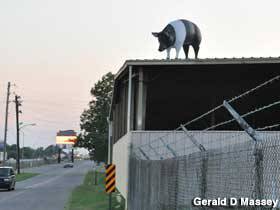
Roof pig. Most unexpected.
Standout Performance: It’s impossible to know who played who, as Godfrey Ho applied his usual passion for detail to the credits list. Whoever played Mr. Ho is my favorite in the film, mostly because he’s such a blatant creep throughout, I have to wonder how he managed to slip through life without the cops raiding his house for the locker of human meat he’s obviously keeping in there.
What’s Wrong: Are you fucking kidding me? Did you miss the part where vampires and ninjas are battling over real estate?
Flash of Competence: The fights aren’t bad in that ‘80s kung fu kind of way.
Best Scenes: It’s not so much a scene as the sound design as a whole. First off, the music for the three switchboard operators sounds like a late ‘70s/early ‘80s sitcom theme. Like the camera is going to find Ted Knight in his living room complaining about all these zombies and ninjas interrupting his golf game.

Those ninjas were too close for comfort.
One of my favorite scenes is when the three switchboard operators are trying to decide what to do about their newfound knowledge. You know, the conspiracy of ninjas and vampires to control the real estate market. Jesus, it hurts typing that. So Joyce isn’t worried because she “has a friend that’s a ninja.” Are ninjas normally out to their friends? Do they come out? Is there a party? Are people debating over the rights of ninjas to marry? Anyway, they decide against calling the cops, because they’ll be fired. And not, you know, because they believe in ninjas and vampires. Instead, they decide to do it on their own.
Okay, so on the boat, they need urine from a virgin to defeat the vampires. No, seriously. Alex, the creepy stalker (yes, they let him on the boat) admits to being a virgin. He pisses in a convenient container, then attempts to fight the vampires with it. It doesn’t go well, making me wonder why this was a plot point in the first place. Then I remembered that plot points are for lesser directors. It does end with the awesome line of Alex asking if he’s in heaven, and one of the ladies responding, “Of course not, we’re all here.” Like everyone knows they’re going straight to hell because they just sent him out there to fight vampires with a bucket of his own terror-piss.
Transcendent Moment: The final battle — which occurs a good 20-30 minutes after we’ve been on the boat with the switchboard operators and completely forgotten about the Red Ninja — really sums up everything about this movie. It’s not even the whole thing. It’s one shot, when the Purple Ninja arrives to assist. Instead of flipping around through the trees, or doing that hilarious tippy-toe run, he goes sliding across the ground on his face, like he’s just been lubed up and hurled onto this air hockey table we call planet Earth. Godfrey Ho probably intended it as yet another way the ninja is inhumanly graceful, but his train of thought hit a whole herd of feeling-buffalo on the tracks, sending the whole bleating mass tumbling into the ravine below. We’re left with a scene that basically looks like some asshole in a bright purple ninja suit being dragged through the woods from the back of an ATV.
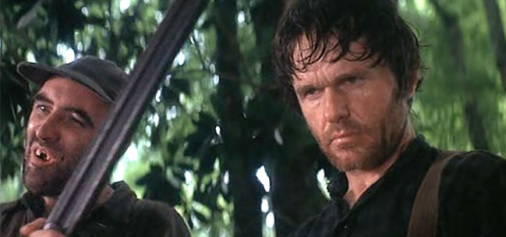
“I dunno, Cletus. You ever think our redneck bullying has gotten a little… conceptual?”
Come on, of course you should watch this one. It’s crazier than a guy breaking into your home to take a dump in your crisper. And there’s a lot less clean up. Just remember, if the vampires and ninjas want your hotel, watch out for car bombs.
Filed under: Puffery, Yakmala! Tagged: godfrey ho, The Vampire Raiders, Vampire Raiders Ninja Queen, vampires vs. ninjas, Yakmala!

September 15, 2016
It's the first review of FIFTY FEET OF TROUBLE!
Check it out, and the book is available on Halloween!
September 9, 2016
Anne Rule’s Too Late to Say Goodbye
True crime has been undergoing a bit of a renaissance, in large part due to Sarah Koenig’s record-shattering podcast Serial. There’s a lot that could be said about what this might mean for civilization (short version, we’re doomed, but you knew that), but I’m not here to talk about that. Especially since I’m one of those people who has been tacitly interested in true crime for most of my life.
In my last office job, I killed time between stressful overreactions (seriously, my boss was insane and, I later found out, a white collar criminal!) by reading the old Crime Library online. Before that, I got into it because of my mother (now immortalized on my twitter feed as #DrunkMom, and yes, all of the quotes are 100% real). She’s read a ton of full-on true crime novels, which was how you had to do things back in the ‘80s because there was no internet or podcasts. She always felt guilty (my mother feels guilty about everything) when I would get her one or more true crime books for Christmas.
In the genre of true crime, one name stands above all others: Anne Rule is the JK Rowling of true crime world. She has a pretty incredible story too. Back in 1971, Rule worked at a crisis hotline center, where she met a young student by the name of Ted Bundy. Yeah, that one. She was so thoroughly snowed by the charming psychopath, she said she used to wish he was ten years older for her or ten years younger for her daughter. Later, after he was unmasked as a monster, she wrote the best seller The Stranger Beside Me. While she didn’t invent the genre, she turned herself into a reliable cottage industry, turning out horror stories with the frequency of Stephen King but with the added allure that these things actually happened. For better or for worse, I knew who Anne Rule was before Truman Capote.
So it was with a small sense of excitement that I recorded this Lifetime movie way back in November of last year. It had two things I enjoy: Anne Rule and Rob Lowe. Oh yeah, Rob Lowe, the man I referred to as the patron saint of Lifetime movies, is in this one. Sadly, he doesn’t put on the virtuosic performance he did for Drew Peterson: Untouchable, and the movie itself isn’t the nonstop madness romp that was Beautiful & Twisted, but Lowe and Rule! I couldn’t miss it!
Just to get it out of the way quick, what you’re picturing in your head about what a team up between these two luminaries filtered through the Lifetime lens would look like is most likely accurate. It has the soulless McMansion interiors, the too-bright lights, and just enough kind of recognizable faces that have become the network’s trademark. The important thing, though, comes in the way the movie is structured. Because it’s super-obvious that these folks have listened to Serial (or watched The Staircase) when they set to write it down.
Serial’s first season was so addictive at least in part, because it oscillated back and forth between the question of Adnan’s guilt. Half of the episodes uncovered things that implied his innocence, while the other half found the opposite. Listeners were on a seesaw, each week tuning in to hear how their view of the case would be entirely blown up. Koenig hewed to this formula so closely, it’s almost impossible to believe she didn’t cook the story at least a little, especially after all of the things that have come out in the wake of the podcast. Now it looks like Adnan is entirely innocent and any suggestion he is guilty is based on either shoddy detective work, or in service to a better story.
This story starts with a woman’s suicide. This woman, Jenn Corbin, is married (to Rob Lowe’s Dr. Barton T. Corbin, DDS, who was apparently a real person and not a VC Andrews character) and has two sons, Trevor and Taylor. One late night, she apparently commits suicide via a single gunshot would to the head. The family is, of course, devastated. While Bart is suspected largely as a matter of course, no one really thinks he had anything to do with the death. But then shit starts getting weird.

No, that’d be entirely expected.
First, there’s the method. Women generally don’t commit suicide with guns, and the specific angle of the shot later proves to be impossible. Then there’s the matter of Jenn’s burgeoning affair. Convinced that Bart is sleeping with fellow dentist Dara (presumably they have the world’s mintiest kisses), she embarks on an online affair with “Chris,” who turns out to be a woman. This was a shock to Jenn, but in a few flashbacks, she’s clearly considering it. This woman is an early red herring, as is her ex-girlfriend, who was insanely jealous and liked to threaten people with a firearm.
This specific red herring — a jilted gun-happy lesbian — is given as a throwaway line. She never appears and does nothing. On one hand, I was bummed at missing out on this character. On the other, I was glad Lifetime wasn’t indulging in any lesbaiting. Once we’re halfway through, Bart is the only real suspect, and his habit of never actually denying any charges (he only gets offended when asked) really starts to look guilty.
Even more guilty? The fact that he had a girlfriend back in dental school who killed herself in the exact same way. This is mostly an excuse for an ‘80s flashback, and I shit you not, the movie fucking rickrolls you. If the rest of the movie were better, I’d be tempted to call my Very Special Series finished. When an entire channel is shooting Rick Astley at you, there’s nowhere really to go. You’ve hit the top. Or bottom, depending on your perspective.
Sadly, a lot of the ‘80s flashback stuff is kind of half-assed. Or it could be I was spoiled by Stranger Things, which was so accurate, I could only complain about things like the D&D rules being wrong, or the Millennium Falcon toy being the modern model. This is Lifetime, after all. They spent most of their money getting Rob Lowe onto set. They’re not going to faithfully recreate 1984. They do sadly drop the ball when she’s describing Lowe’s character to a friend and doesn’t say that “He looks like that guy from St. Elmo’s Fire.”
Anyway, Lowe eventually gets busted and thrown into prison for life, largely due to the (say it with me now) steely determination of a mom. Namely, Jenn’s sister (played by Lauren Holly), who though initially on team Bart comes to her senses. And, oh yeah, Bart was totally having an affair, just like Jenn thought.
So what did we learn? If a family member kills themselves, it’s probably due to a homicidal spouse. Look into their pasts for other bodies. Those things pile right up.
Filed under: Projected Pixels and Emulsion Tagged: Anne Rule, Anne Rule's Too Late to Say Goodbye, Lauren Holly, Lifetime Theater, Rob Lowe, true crime

September 2, 2016
"Vengeance is Fine," a brand new free CITY OF DEVILS story!
Good news to all the Haineheads out there! To celebrate the release next month of Fifty Feet of Trouble, I've gone ahead and written a little story starring Sam, called "Vengeance is Fine". Taking place a year before the events of City of Devils it's a quick dip back into the world before the big sequel!
And it's totally free. Can't beat that!
Now Fear This: From the Dark
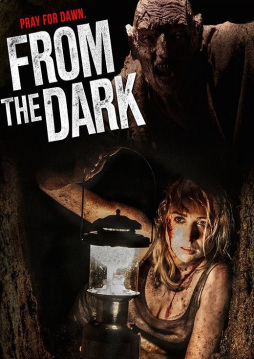
He looks nice.
I’ll admit it. I’m a sucker for simplicity. Strand the bare minimum of characters in a single, isolated location and torment them with a never-fully-glimpsed monster, and you’ll have my full attention for the next hundred minutes. I enjoy the challenge of skeletal storytelling, of crafting a compelling narrative using the least possible amount of parts. It’s like the challenge of putting up Ikea furniture while keeping a bunch of spare hürgenflürga and veurüglømürgs. Sure, there’s a chance you’ll end up collapsed under a pile of jøtünglürms, but there’s also the chance you’ll make magic.
This kind of storytelling lends itself to shoestring budgets. When the makers of Saw realized they had five grand to make a movie, they shrugged and were like, “Okay, I guess this is going to be about two people in a room.” So as much as that series is now synonymous with the ugliness of torture porn and the lengths to which a studio will go to wring blood from a stone, I respect the fiendish inventiveness that brought the series into creation. Two guys wanted to make a movie and they worked with what they had. And they went on to do some pretty great stuff.
Because these kinds of stories are often told by outsiders with no money, I tend to be a little easier on them. Compare my Yakmala reviews of indie flicks to those with Hollywood juggernauts behind them. For the former, I like to find something to praise, even if I’m reveling in their cheapness. For the latter, I’m coming up with the most brutal slams I can on a Monday morning. Comedy is about punching up, after all. Someone who is able to craft even the most basic of stories out of the amount of money that would buy one epipen, well, they have my respect.
This week’s movie, the 2014 Irish import From the Dark looks like it is roundly hated. Rocking a 4.8 on the IMDB and one of the most brutal one star reviews this side of, well, my hatchet job on Fantastic Four , this is the poor kid on the playground everyone picks on because they haven’t learned to be decent people yet. I kind of get where the vitriol is coming from. This is far from a perfect movie. But for what it is, it’s a startlingly effective diversion, and worth the time of any horror fan looking for an unjustly reviled film to champion.
As appropriate for a movie like this one, the cast list is a whopping four people long. Our everypeople heroes are Mark and Sarah, an Irish couple driving through the countryside on a vacation (they’d call it a holiday, in blatant defiance to what that word means), who come upon an isolated farmhouse where something awful is happening. We get a quick window to that in a cold open, making this film structured almost like an episode of X-Files. A lone farmer, working into the night, unearths something strange on his property. That thing attacks and apparently wounds the farmer severely. Our heroes discover the farmer in the aftermath of the attack.
The monster is never explained and never seen in anything approaching light — for good reason. This leaves the audience up to determine precisely what it is, as well as allowing the imagination to fill in the holes in makeup design that a shoestring budget will necessarily leave. In any rate, the monster transforms its victims into raging killers who share the beast’s own allergy to bright light. Light will drive the monster and its victims away, or enough of it will wound or even kill. For Sarah, who rapidly turns into the sole hero when Mark is first wounded and then transformed, she is forced to use whatever she can find to produce light. In one of the film’s better themes, she has to resort to increasingly primitive methods: starting with the light on her smartphone, then to an old electric desk lamp, then finally to open flame.
As appropriate for an action survivor like Sarah, she’s put through the wringer, and has to take actions she never thought were possible only a day before. The Sarah Connor arc in the first Terminator, though appropriate for our modern age, she is never quite as helpless as Linda Hamilton’s character is in the beginning of that movie. Sarah is outmatched from the first moment, and quickly outnumbered. Mark is barely any help even before his attack, which is the whole point. Because here’s the interesting part about From the Dark: it’s all about marriage.
What feels like a post-Tarantino bantering session in the car at the beginning actually establishes the entire struggle of Sarah’s character. Mark casually mentions that he never wants to get married, and from Sarah’s pregnant pauses and pointed tone, it’s pretty obvious that this is news to her. Sarah clearly sees this relationship, and maybe this particular vacation, as a test drive for a future husband, and is only just now getting the news that he’s not that into her. Appropriate then, that she begins the film wearing white.
Tracking the state of her outfit through the movie is a window not just to how dire her straits, but where she is, at least symbolically, on the subject of commitment. In the beginning, this stuff is brand new, or she has some amazing detergent. By the midpoint, it’s getting soiled, looking more gray than anything. By the end, it’s the brownish tan of a desert military uniform. To really hammer the symbolism home, she’s later wounded — by Mark — in her finger and severs it to avoid being infected. The finger in question? Her ring finger.
In the beginning of the film, Mark was a fine partner, revealing his true character only in an offhanded comment. But by this point, he has been transformed into a raging abuser. She’s not just rejecting him, or marriage, but symbolically severing the possibility of a relationship with him or any other. She doesn’t want to be “infected” with the rage that’s poisoning him. And what’s the one thing that can stop the monster her symbolic husband has become? Light, i.e. attention, visibility, and truth.
From the Dark isn’t a perfect film. The middle sags a bit and not every one of the scares land. But it was created on a wing and a prayer and features enough depth of writing to elevate it above many of its genre-mates. Ignore the crappy reviews. See it for yourself.
Filed under: Projected Pixels and Emulsion Tagged: fear of the dark, From the Dark, Now Fear This, simplicity, spare narrative




